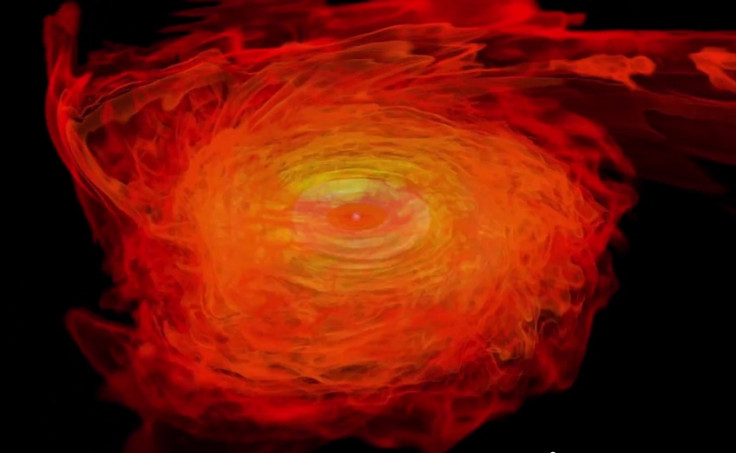Nasa Video: Super-Dense 'Neutron Stars' Violent Collision Creates Black Hole
Nasa has released a video animation depicting the collision of two super-dense neutron stars, resulting in the creation of a black hole.
Neutron stars are the densest and tiniest stars known to exist in the universe. According to Nasa, a neutron star can have a mass equal to 1.5 times the mass of the sun, yet it is compressed into a sphere measuring just 12 miles across.
They are a leftover remnant of a supernova event, the explosive death of a much larger star, and are likely to appear white to the naked eye. One cubic centimeter of a neutron star could outweigh Mount Everest.
The video, which shows the stars merge in a cataclysmic event which creates a black hole, was created by scientists at Nasa's Goddard Space Flight Center using a supercomputer.

As the two stars spiral together, the biggest stellar remnant obliterates the smaller one, causing it to explode and form a spiral around the large star.
"At 13 milliseconds, the more massive star has accumulated too much mass to support it against gravity and collapses, and a new black hole is born," NASA officials told Space.com.
"The black hole's event horizon — its point of no return — is shown by the grey sphere. While most of the matter from both neutron stars will fall into the black hole, some of the less-dense, faster-moving matter manages to orbit around it, quickly forming a large and rapidly rotating torus."
Neutron stars form when a larger star, between eight to 30 times the mass of the sun, erupts as a supernova. The compressed, dense core - the neutron star - is left behind.
Although the clip lasts two minutes, the actual event would take milliseconds. Nasa told Sky News: "Neutron stars possess incredible density - but their surfaces are comparatively thin - with densities about a million times greater than gold. By seven milliseconds, tidal forces overwhelm and shatter than lesser star."
"At 13 milliseconds, the more massive star has accumulated too much mass to support it against gravity and collapses, and a new black hole is born," Nasa added.
Researchers believe that the violent collisions between neutron stars also produce short gamma-ray bursts, as reported by Science Recorder.
Although the blasts only last a few seconds, they release the same amount of energy as all of the stars in the Milky Way produce in over a year.
Astronomers want to study the gamma-ray explosions using instruments on the ground, using information collected by Nasa's Swift satellite.
In 2013, Science News online reported that images snapped by the Hubble Space Telescope suggested gold may have been generated by an explosive neutron star collision. It may have also produced platinum, uranium and several other heavy elements.
© Copyright IBTimes 2025. All rights reserved.






















